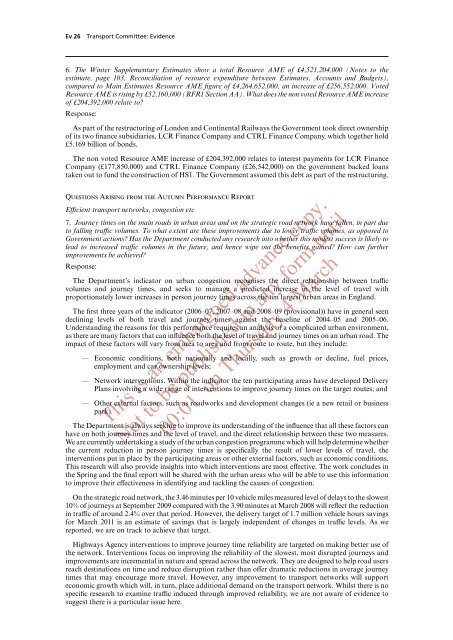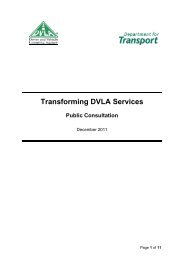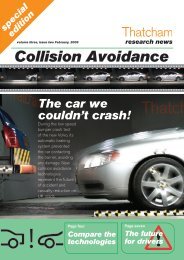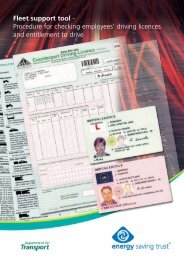The performance of the Department for Transport - Fleet News
The performance of the Department for Transport - Fleet News
The performance of the Department for Transport - Fleet News
Create successful ePaper yourself
Turn your PDF publications into a flip-book with our unique Google optimized e-Paper software.
Processed: 26-02-2010 19:10:26 Page Layout: COENEW [E] PPSysB Job: 442441 Unit: PAG2Ev 26<strong>Transport</strong> Committee: Evidence6. <strong>The</strong> Winter Supplementary Estimates show a total Resource AME <strong>of</strong> £4,521,204,000 (Notes to <strong>the</strong>estimate, page 103, Reconciliation <strong>of</strong> resource expenditure between Estimates, Accounts and Budgets),compared to Main Estimates Resource AME figure <strong>of</strong> £4,264,652,000, an increase <strong>of</strong> £256,552,000. VotedResource AME is rising by £52,160,000 (RFR1 Section AA). What does <strong>the</strong> non voted Resource AME increase<strong>of</strong> £204,392,000 relate to?Response:As part <strong>of</strong> <strong>the</strong> restructuring <strong>of</strong> London and Continental Railways <strong>the</strong> Government took direct ownership<strong>of</strong> its two finance subsidiaries, LCR Finance Company and CTRL Finance Company, which toge<strong>the</strong>r hold£5.169 billion <strong>of</strong> bonds.<strong>The</strong> non voted Resource AME increase <strong>of</strong> £204,392,000 relates to interest payments <strong>for</strong> LCR FinanceCompany (£177,850,000) and CTRL Finance Company (£26,542,000) on <strong>the</strong> government backed loanstaken out to fund <strong>the</strong> construction <strong>of</strong> HS1. <strong>The</strong> Government assumed this debt as part <strong>of</strong> <strong>the</strong> restructuring.Questions Arising from <strong>the</strong> Autumn Per<strong>for</strong>mance ReportEYcient transport networks, congestion etc7. Journey times on <strong>the</strong> main roads in urban areas and on <strong>the</strong> strategic road network have fallen, in part dueto falling traYc volumes. To what extent are <strong>the</strong>se improvements due to lower traYc volumes, as opposed toGovernment actions? Has <strong>the</strong> <strong>Department</strong> conducted any research into whe<strong>the</strong>r this modest success is likely tolead to increased traYc volumes in <strong>the</strong> future, and hence wipe out <strong>the</strong> benefits gained? How can fur<strong>the</strong>rimprovements be achieved?Response:<strong>The</strong> <strong>Department</strong>’s indicator on urban congestion recognises <strong>the</strong> direct relationship between traYcvolumes and journey times, and seeks to manage a predicted increase in <strong>the</strong> level <strong>of</strong> travel withproportionately lower increases in person journey times across <strong>the</strong> ten largest urban areas in England.<strong>The</strong> first three years <strong>of</strong> <strong>the</strong> indicator (2006–07, 2007–08 and 2008–09 (provisional)) have in general seendeclining levels <strong>of</strong> both travel and journey times against <strong>the</strong> baseline <strong>of</strong> 2004–05 and 2005–06.Understanding <strong>the</strong> reasons <strong>for</strong> this <strong>per<strong>for</strong>mance</strong> requires an analysis <strong>of</strong> a complicated urban environment,as <strong>the</strong>re are many factors that can influence both <strong>the</strong> level <strong>of</strong> travel and journey times on an urban road. <strong>The</strong>impact <strong>of</strong> <strong>the</strong>se factors will vary from area to area and from route to route, but <strong>the</strong>y include:— Economic conditions, both nationally and locally, such as growth or decline, fuel prices,employment and car ownership levels;— Network interventions. Within <strong>the</strong> indicator <strong>the</strong> ten participating areas have developed DeliveryPlans involving a wide range <strong>of</strong> interventions to improve journey times on <strong>the</strong> target routes; and— O<strong>the</strong>r external factors, such as roadworks and development changes (ie a new retail or businesspark).This is an embargoed advance copy.Not to be published in any <strong>for</strong>m until00:01 on Thursday 4 March<strong>The</strong> <strong>Department</strong> is always seeking to improve its understanding <strong>of</strong> <strong>the</strong> influence that all <strong>the</strong>se factors canhave on both journey times and <strong>the</strong> level <strong>of</strong> travel, and <strong>the</strong> direct relationship between <strong>the</strong>se two measures.We are currently undertaking a study <strong>of</strong> <strong>the</strong> urban congestion programme which will help determine whe<strong>the</strong>r<strong>the</strong> current reduction in person journey times is specifically <strong>the</strong> result <strong>of</strong> lower levels <strong>of</strong> travel, <strong>the</strong>interventions put in place by <strong>the</strong> participating areas or o<strong>the</strong>r external factors, such as economic conditions.This research will also provide insights into which interventions are most eVective. <strong>The</strong> work concludes in<strong>the</strong> Spring and <strong>the</strong> final report will be shared with <strong>the</strong> urban areas who will be able to use this in<strong>for</strong>mationto improve <strong>the</strong>ir eVectiveness in identifying and tackling <strong>the</strong> causes <strong>of</strong> congestion.On <strong>the</strong> strategic road network, <strong>the</strong> 3.46 minutes per 10 vehicle miles measured level <strong>of</strong> delays to <strong>the</strong> slowest10% <strong>of</strong> journeys at September 2009 compared with <strong>the</strong> 3.90 minutes at March 2008 will reflect <strong>the</strong> reductionin traYc <strong>of</strong> around 2.4% over that period. However, <strong>the</strong> delivery target <strong>of</strong> 1.7 million vehicle hours savings<strong>for</strong> March 2011 is an estimate <strong>of</strong> savings that is largely independent <strong>of</strong> changes in traYc levels. As wereported, we are on track to achieve that target.Highways Agency interventions to improve journey time reliability are targeted on making better use <strong>of</strong><strong>the</strong> network. Interventions focus on improving <strong>the</strong> reliability <strong>of</strong> <strong>the</strong> slowest, most disrupted journeys andimprovements are incremental in nature and spread across <strong>the</strong> network. <strong>The</strong>y are designed to help road usersreach destinations on time and reduce disruption ra<strong>the</strong>r than oVer dramatic reductions in average journeytimes that may encourage more travel. However, any improvement to transport networks will supporteconomic growth which will, in turn, place additional demand on <strong>the</strong> transport network. Whilst <strong>the</strong>re is nospecific research to examine traYc induced through improved reliability, we are not aware <strong>of</strong> evidence tosuggest <strong>the</strong>re is a particular issue here.









